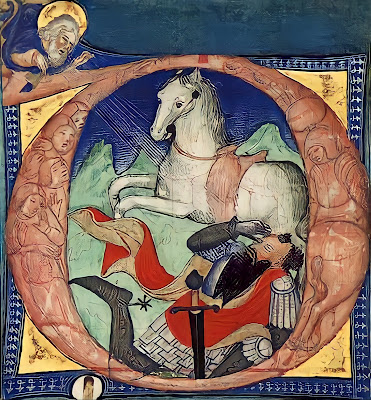January 25 is the Feast of the Conversion of Saint Paul. The first of my monthly "Conversion Stories" series addressed this dramatic and archtypal New Testament conversion, and appeared in the December 2013 issue of Magnificat. Obviously, Paul's conversion is as marvelous today as it was to the astonished Christians of Damascus in the First Century. Here is the text of my article:
Saint Paul’s conversion from persecutor to Apostle is the radical instance of what constitutes every Christian conversion. His experience is fundamentally an encounter with the person of Jesus Christ who communicates himself in and through his Church. It reveals at this very early moment in Christian history an essential feature of the mystery of the Church: Jesus identifies himself with those who follow him, and extends his visible and missionary presence in time and space through them.
Of course, we are familiar with the story. After presiding over the stoning of Saint Stephen, Saul obtains letters from the high priest so that he can arrest Christians in Damascus. He is “breathing threats and murder against the disciples of the Lord” (Acts 9:1). Saul has met the followers of “the Way,” but there has been no real encounter; he doesn’t see that the God he longs for and seeks to please with a desperate zeal is communicating himself as a free gift in the midst of these people. “I had acted ignorantly in unbelief” (1 Timothy 1:13), he explains later.
Saint Paul is converted by the famous “light from heaven” on the road to Damascus, in which Jesus reveals himself in his own voice, and at the same time indicates that he is the object of Saul’s persecution: “I am Jesus, whom you are persecuting” (Acts 9:5). It is Jesus himself who opens Paul’s eyes and enables him to see that Christians are not an errant Jewish sect but the very presence of God’s redeeming love in the world.
The light from the glory of Jesus blinds Saul, and it is fitting that a disciple from Damascus, Ananias, is sent to him after three days to restore his sight and baptize him. After this, Saul is completely changed. Immediately we hear in very simple terms that he is “with the disciples at Damascus” and “in the synagogues immediately he proclaimed Jesus, saying, ‘He is the Son of God’” (Acts 9:19-20).
For Saul, conversion comes from the completely gratuitous gift of God, from an encounter that is pure mercy: “the grace of our Lord overflowed for me with the faith and love that are in Christ Jesus” (1 Timothy 1:14). The grace of this encounter with Jesus corresponds to a recognition of who the followers of Jesus really are, and an insertion of himself into this reality, the Church, and into its mission of witness.
Saint Paul’s miraculous conversion is one of the great events of the New Testament. Nevertheless, in it we can see the basic features that make up every conversion story. It was not just a change of convictions. Paul encountered a person, Jesus, who identified himself with persons that Paul knew or would come to know. He recognized Jesus in these persons, the disciples, and in his own transformed life (“it is no longer I who live, but it is Christ who lives in me” [Galatians 2:20] ) as he also witnessed Jesus through the grace of faith and love.
Conversion is always a work of grace. It is always an encounter with Jesus in the communion of the Church. St. Paul’s story is reenacted, again and again, in less outwardly dramatic ways, in every place, in every time, to so many different kinds of people.
